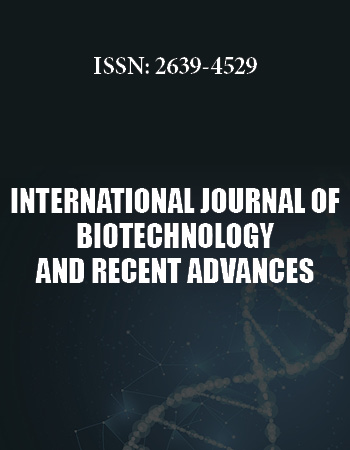Research Article
Impact of Zinc Supplementation on Growth Performance, Carcass Traits and Immune Response in Broilers Fed Antibiotic free Diet
1Department of Animal Nutrition, Faculty of Animal Production and Technology, University of Veterinary and Animal Science, Lahore, Pakistan
2Department of livestock Production, Faculty of Animal Production and Technology, University of Veterinary and Animal Science, Lahore, Pakistan
3Department of Animal Nutrition, Faculty of Animal Husbandry, University of Agriculture, Faisalabad, Pakistan
4Department of Reproduction, Faculty of Veterinary Science, University of Agriculture, Faisalabad, Pakistan
*Corresponding author: Ahsan Jamal, Department of Animal Nutrition, Faculty of Animal Production and Technology, University of Veterinary and Animal Science, Lahore, Pakistan, E-mail: ahsanalvi119@gmail.com
Received: August 28, 2019 Accepted: September 19, 2019 Published: September 25, 2019
Citation: Ali M, Jamal A, Saeed H, Abiden MZ, Nawaz MH, Irfan A. Impact of Zinc Supplementation on Growth Performance, Carcass Traits and Immune Response in Broilers Fed Antibiotic free Diet. Int J Biotechnol Recent Adv. 2019; 2(1): 60-63. doi: 10.18689/ijbr-1000110
Copyright: © 2019 The Author(s). This work is licensed under a Creative Commons Attribution 4.0 International License, which permits unrestricted use, distribution, and reproduction in any medium, provided the original work is properly cited.
Abstract
The aim of the present study was to evaluate the role of zinc supplementation on growth performance, carcass traits and immune response of broilers fed antibiotic free diet. Four hundred day old broiler chicks were randomly divided into five treatments with four replicates (twenty birds/treatments). Experimental group include ZN0: control group with basic diet, ZN40: basic diet with supplemented 40 mg/kg zinc, ZN80: basic diet with supplemented 80 mg/kg zinc, ZN120: basic diet with supplemented 120 mg/kg zinc and ZN160: basic diet with supplemented 160 mg/kg zinc. The experimental diets were formulated according to the NRC standards. Results indicated that there was decline in weight gain, feed intake and FCR with increasing level of zinc above 80 mg/kg in diet. Weight gain and feed intake was higher (P<0.05) in the ZN80, whereas lower FCR as compared to other treatments. Dressing percentage was higher (P<0.05) in ZN80. ZN80 costs lower price for production per kg as compared to rest of treatments. It was concluded that supplementation of zinc 80 mg/kg above NRC recommended level improved growth and economical with lower FCR during antibody free rearing of broiler birds.
Keywords: Antibody resistance; Mineral; Immunity.
Introduction
Poultry sector is the major industry, growing exponentially to fulfil the growing needs of meat and eggs of the world. Despite tremendous growth rate, the sector has encountered different challenges like microbial resistance, immunosuppressive diseases (Avian influenza and Newcastle disease) and emergence of different types of pathogens due to intensive use of chemotherapeutic agents in poultry production. Immune suppression is one of major issues in poultry industry which has deleterious effects on productive performance of birds and cause heavy economics losses. Zinc plays a crucial role to overcome these problems by boosting up the immunity of bird and ultimately protect from high economic losses through [1].
Zinc is a nutritionally essential micro mineral playing a significant role, in many biochemical processes such as amino acid metabolism and gene expression [2]. Hays and Swenson [3] concluded that zinc plays a vital role in metabolism of macro nutrients and cell multiplication. Zinc has found to play vital role in the synthesis of antioxidant enzyme (superoxide dismutase) during stress conditions. On the other hand, antioxidant activity of Zn supplementation has shown the encouraging results on meat quality of broiler through enhanced shelf life and improved meat characteristics. Furthermore, zinc has been documented to propagate immune cells through release of cytokines and induction of cells proliferation.
Zinc deficiency causes loss of appetite, reduced efficiency of feed utilization and consequent retardation in factors dealing with growth. Keilin and Mann [4] documented that, zinc is an integral part of many enzymes, such as DNA and RNA polymerase which are responsible in normal organs developments, so its deficiency hinders the structural growth of organs. Supplementation rate of zinc in all poultry diet is 0.012-0.018% [5,6]. Common inorganic zinc sources which are used in formulation are the oxides (ZnO) and feed grade sulfate (ZnSO4.7H2O). Organic sources of zinc include Zn lysine, Zn methionine and Zn picolinic acid. Among inorganic sources zinc sulphate is more bio-available than zinc oxide having a bioavailability between 61 to 77% compared to zinc sulfate [7]. Mohanna and Nys [8] documented that zinc methionine and ZnSO4 are equally effective in improving growth and zinc status in day old broiler.
Current study was design to optimize growth performance and immunity of birds. Keeping in view the importance as well as challenges of immune related disease in poultry industry, the present study will help to find out optimum level of zinc in diet to minimize these problems and boosting the economic.
Materials and Methods
Experimental design
This experiment was conducted at Research and development farm, Sharif Feed Mill Pvt. Ltd. Total duration of experiment was 42 days. Four hundred day old broiler chicks ROSS 308 were randomly divided into five treatments with four replicates (twenty birds in each replicate). Experimental group include ZN0: control group with basic diet, ZN40: basic diet with supplemented 40 mg/kg zinc, ZN80: basic diet with supplemented 80 mg/kg zinc, ZN120: basic diet with supplemented 120 mg/kg zinc and ZN160: basic diet with supplemented 160 mg/kg zinc (Table 1).

Feed intake and weight gain
A calculated quantity of feed was offered to each treatment throughout the week. Orts were weighed at the end of each week to estimate weekly feed intake. All chicks were weighed at start and thereafter on weekly basis. Feed conversation ratio determined at end of experiment.
Dressing percentage
At the end of experiment, ten birds from each replicate were selected and slaughtered to calculate the dressing percentage after removing all visceral organs. Immune organs (spleen and bursa) were separated carefully and weighted using an electric weighing balance machine.
Collection and analysis of serum samples
Two birds from each replicate were selected and blood sampling was collected at 42 days of age. Blood samples were collected from wing vein, put into BD vacucontainer and moved to Quality operational lab (QOL) UVAS, Lahore. Serums were separated and stored at -20°C then; titters of (Newcastle disease) ND were analyzed by using the Haeme-agglutination & Haeme-agglutination inhibition test. Prior to perform the HI test, serum samples were thawed and placed in water bath at 56°C up to 20-30 minutes to destroy heat labile non-specific agglutinins.
Blood mineral profile
At the end of experiment, 40 birds were selected randomly and two ml of blood was taken from the wing vein of each bird in sterile syringe. Syringes were kept in tilted position at 45 degree angle to obtain the serum and stored at 20°C prior until further analysis. Sample was first digested and then analyzed for calcium, phosphorus, zinc and magnesium using atomic absorption spectrophotometer (Perkin-Elmer, AA400).
Statistical analysis
Data were tested for normality using QQ plots and then analysed using mixed procedures of SAS Model SAS (University edition SAS Institute Inc., Cary NC, USA). Data for weekly feed intake, weekly weight gain and Feed Conversation Ratio (FCR) were analysed by repeated measure analysis of variance (ANOVA) technique. Data for blood mineral profile, dressing percentage, and immune organ weight were analysed by one-way ANOVA. Results were declared statistically significant at P ≤ 0.05 and trend at P ≤ 0.10.
Results
Weight gain
Average weight gain of broilers fed different rations is presented in table 2. Final weight gain was higher in ZN80 as compared to the ZN0 and ZN160. However final weight was higher in the ZN160 as compared ZN0. Average weight gain was lower in ZN0 as compared to other treatments during first and third week. During second, fourth and fifth week weight gain was higher in ZN80 among other treatments.
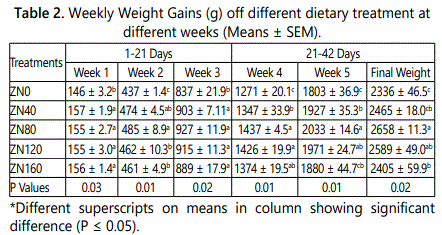
Feed intake
The results of feed intake of broilers fed different levels of zinc at different weeks are shown in table 3. Results showed that highest feed intake ZN80 was observed in Zn40 and lowest ZN0. Statistical analysis showed that the mean of different treatments of feed intake in second, fourth and fifth week were significantly different (P ≤ 0.05) to each other and non-significant in first and third week.
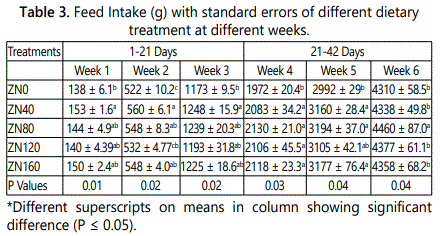
Feed conversion ratio
Feed conversion ratio of broilers fed different levels of zinc in diet are shown in table 4. Results showed that highest feed conversion was observed in ZN0 and lowest was observed in ZN80 at the end of experiment. Statistical analysis showed that there was no significant effect (P ≤ 0.05) observed in 1 to 21 days of age and in last 22-42 days there was significant difference (Table 4).
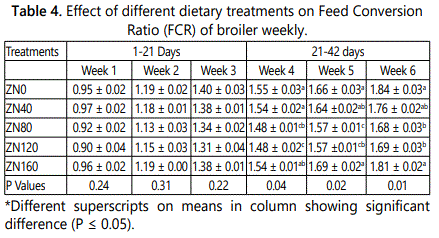
Dressing percentage and immune organs weight
Dressing percentage of different treatment groups is shown in table 5. It was highest in ZN80 lowest was observed in the ZN0. Dressing percentage was higher in ZN120 as compared to the ZN0 but lower than the ZN80. However, percentage of spleen bursa weight remains unchanged among all treatments.
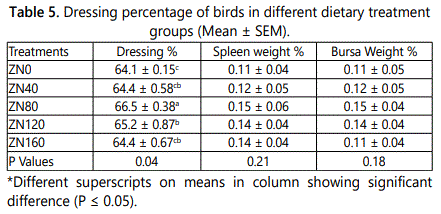
Blood mineral profile
Mineral profile of broilers fed different levels of zinc in diet is shown in table 6. Results showed that there was a significant difference (P ≤ 0.05) in calcium, magnesium and zinc levels. Highest calcium was found in the ZN0 as compared to the ZN160. Magnesium level was higher in ZN0 as compared to the ZN80, ZN120 and ZN160. Zinc level was higher in ZN160 as compare to the ZN0. However phosphorus and antibody titer (ND) remain unchanged among all treatments.
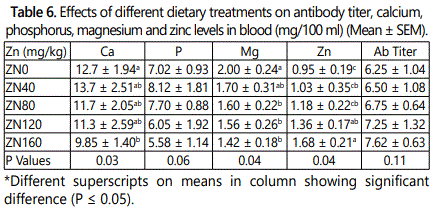
Economics
Table 7 shows the feed cost per kg live weight. Diet with 80 mg/kg of zinc supplemented (ZN80) proved to be the most economical ration. This group gained highest body weight among all treatment groups as well as highest total live weight so feed cost per kg of live body weight was economical in this treatments.
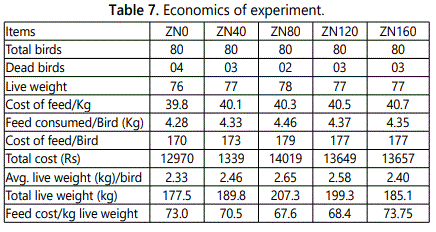
Discussion
The result showed that supplementation of zinc in antibody free diet increase the body weight of broilers when added within range of 40 to 80 mg/kg feed. Optimum level of Zn is considered as crucial element in maintaining the structure of metallic-proteins such as insulin and growth hormone. Zinc deficiency mainly affects protein metabolism in fast-growing animals. The result of present study was in line with Saenmahayak [9], who used different zinc level in broiler feed and concluded that Zn had significant effect on body weight gain at 13, 27 and 40 days of age. Burrell et al. [10] also used different concentration of zinc @ 0, 20, 40 and 80 mg/kg and end result showed highest body weight gain was achieved at 80 mg/kg. In another experiment, Ezzati et al. [11] used 50, 75, 100 and 125 mg/kg of Zn in feed. They concluded that dietary zinc increased body weight gain and feed intake of broiler, however they resulted 100 mg/kg of zinc as better (P ≤ 0.05) level. The result of present study is also in agreement with Liu et al. [12]. They used 60, 120 and 180 mg/kg of zinc and concluded that Zn had effective role on feed intake and weight gain.
Result of feed intake was in agreement with Ezzati et al. [11]. They used different level of zinc 50, 75, 100 and 125 mg/kg and observed effect on growth performance parameters and result concluded that dietary Zn increased the body weight gain and feed intake of broiler. They also concluded that body weight gain and feed intake was improved with 100 mg/kg of zinc level but no difference was observed between 100 and 125 mg/kg of zinc level.
The FCR result of present study was in line with Sahraei et al. [13]. They used different sources of zinc and observed bio-availability and result concluded that feed conversion ratio was improved. Improved FCR was noticed with increase in zinc supplementation that improved the feed utilization.
Result showed that supplementation of zinc to broiler had effect on dressing percentage of broiler. In this current study, increase in dressing percentage of broilers resulting from dietary zinc might be due to improvement in growth performance and increase the percentage of breast muscles. Sahin et al. [14] used Zn @ 0, 30 and 60 mg/kg and Vitamin E @ 0, 250 and 500 mg/kg in broilers and result showed that linear increase in carcass yield which was in parallel to our study.
Result showed that supplementation of zinc in diet had no effect (P ≤ 0.05) on spleen and bursa weight of birds. But it was higher in all zinc supplemented treatments than control. The result of present study was in agreement with Shyam Sunder et al. [15]. They used zinc with basal diet used as control and other six treatments were supplemented with zinc 10, 20, 40, 80, 160 and 320 mg/kg and concluded that weight of spleen and bursa was higher in Zn supplemented groups as compared to control.
Result showed that calcium and phosphorus level was increase with supplementation of zinc from control to 40 mg/kg of diet and then level decrease with more addition. The result of present study was parallel with findings of Shyam Sunder et al. [15]. They conducted an experiment on mineral availability and result concluded that calcium level was lower in birds which was not supplemented with zinc and then increases up-to 80 mg/kg and decrease thereafter. This decline in calcium level may be due to limitations of zinc supplementation at minimum and maximum levels. Similarly phosphorous level was lower in birds fed without zinc and higher value was achieved at 40 mg/kg of diet then decrease. This decline in phosphorous level may be due to restrictions of zinc supplementation at higher and lower levels. The result of present study was similar with Underwood [16]. He concluded that higher level of zinc in diet hamper the absorption and utilization of calcium and phosphorus. Result showed that supplementation of zinc had no difference (P ≤ 0.05) on immunity of birds but had a progressive response with increased level of zinc in diet. The result of current study was in agreement with Shyam Sunder et al. [15]. Higher level of zinc beyond the normal physiological requirement may have no valuable effect. The result was also in line with Chitithoti et al. [17]. They conducted an experiment to examine immune stimulatory response on zinc on broilers and result showed that there was an increase immune response to ND titer at 80 mg/kg diet.
References
- National Research Council. Nutrient Requirements of poultry. 9th Edition. Washington, DC. National Academy Press. 1994.
- Hurley. Teratogenic aspects of manganese, zinc and copper in nutrition. Physiol Rev. 1981; 61(2): 249–295. doi: 10.1152/physrev.1981.61.2.249
- Keilin D, Mann T. Carbonic anhydrase. Purification and nature of the enzyme. Biochem J. 1940; 34(8-9): 1163–1176. doi: 10.1042/bj0341163
- Batal AB, Parr TM, Baker DH. Zinc bioavailability in tetrabasic zinc chloride and the dietary zinc requirement of young chicks fed a soy concentrate diet. Poult Sci. 2001; 80(1): 87-90. doi: 10.1093/ps/80.1.87
- Leeson S, Summers JD. Commercial Poultry Nutrition. 2nd edition. University Books, Guelph, Ontario, Canada. 1997: 1–9.
- Wedekind KJ, Hortin AJ, Baker DH. Methodology for assessing zinc bioavailability: efficacy estimates for zinc-methionine, zinc sulfate, and zinc oxide. J Anim Sci. 1992; 70(1): 178–187. doi: 10.2527/1992.701178x
- Mohanna C, Nys Y. Effect of dietary zinc content and sources on the growth, body zinc deposition and retention, zinc excretion and immune response in chickens. Br Poult Sci. 1999; 40(1): 108–114. doi: 10.1080/00071669987926
- Saenmahayak B, Bilgili S F, Hess J B Singh M. Live and processing performance of broiler chickens fed diet supplemented with complexed zinc. J Appl Poult Res. 2010; 19(4): 334–340. doi: 10.3382/japr.2010-00166
- Burrell, AL, Dozier WA 3rd, Davis AJ, et al. Responses of broilers to dietary zinc concentrations and sources in relation to environmental implications. Br Poult Sci. 2004; 45(2): 255–263.
- Ezzati MS, Bozorgmehrifard MH, Bijanzad P, et al. Effect of different level of zinc supplementation on broilers performance and immune response to Newcastle disease vaccine. Euro J Exp Bio. 2013; 3(5): 497–501.
- Liu ZH, Lu L, Li SF, et al. Effects of supplemental zinc source and level on growth performance, carcass traits and meat quality of broilers. Poult Sci. 2011; 90(8): 1782–1790. doi: 10.3382/ps.2010-01215.
- Sahraei M, Janmmohamadi H, Taghizadeh A, Ali Moghadam G, Rafat SA. Estimation of the Relative Bioavailability of Several Zinc Sources for Broilers Fed a Conventional Corn-Soybean Meal Diet. Biotech Anim Husbandry. 2012; 28(3): 441–453. doi: 10.2298/BAH1203441S
- Sahin K, Smith MO, Onderci M, Sahin N, Gursu MF, Kucuk O. Supplementation of zinc from organic and inorganic sources improves performance and antioxidant status of heat-distressed quail. Poult Sci. 2005; 84(6): 882–887. doi:10.1093/ps/84.6.882
- Shyam Sunder G, Panda AK, Gopinath NCS, et al. Effects of Higher Levels of Zinc Supplementation on Performance, Mineral Availability and Immune Competence in Broiler Chickens. J Appl Poult Res. 2008; 17(1): 79–86. doi: 10.3382/japr.2007-00029
- Underwood EJ. The mineral nutrition of livestock. 2nd edition. Commonwealth Agriculture Bureau, Slough, UK. 1981.
- Chitithoti AK, Venkata RJ, Jwalapu RP, Devanesan SS, Reddy S. Immune stimulatory effect of dietry supplementation of zinc sulphate and zincmethionine on immune response in broilers. Adv Appl Sci Res. 2012; 3(5): 2785–2788.

